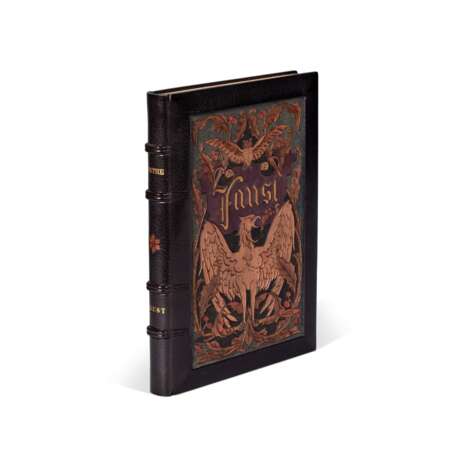ID 1076559
Lot 36 | Johann Wolfgang von Goethe | Faust, Paris, 1880, a “cuir ciselé” binding by Charles Meunier
Valeur estimée
£ 4 000 – 6 000
Faust. Paris: A. Quantin, 1880
NUMBER 47 OF 45 COPIES ON CHINE, LARGE PAPER, from an edition of 100 copies, small folio (328 x 222mm.), 11 etchings by Adolphe Lalauze (portrait frontispiece, one text-framing vignette, one headpiece, and eight full-page engravings), all in two states, one on Japon nacre and one on Japanese paper; woodcut headpiece vignettes by Meaulle after Wogel and Scott, EXTRA-ILLUSTRATED with seven etchings by Laurens engraved by Champoillon, each in two states, DARK BROWN CRUSHED MOROCCO WITH RICHLY SYMBOLIC CUIR CISELÉ DECORATION BY CHARLES MEUNIER, stamp-signed in gilt and dated 1902 on front turn-in, upper cover with a very large central panel onlaid with carved tan leather pieces representing the Lilith demon as an eagle with human breasts, the bird’s claws clutching a rod from which spring twining branches of holly, above the eagle a cartouche of purple calf carved with gilt tile, and above this, a screeching owl with wings spread, the lower cover with similar panel, this onlaid with a carved tanned leather daisy (marguerite), turn-ins with gilt rules and inlaid red and tan morocco flowers, rust-coloured watered silk endleaves, marbled flyleaves, all edges gilt
This is a finely printed bibliophile’s copy of Goethe’s masterpiece, with two sets of illustrations that display varying views of the characters and scenes, all in a splendid binding by the always-innovative Charles Meunier. Here, he employs the screech owl to signal impending death and the Lilith demon to embody the wickedness that seduced Faust. The simple daisies on the lower cover represent both the name and the innocence of the tragic heroine, Marguerite—her name being the French word for daisy, a flower symbolic of youth and naïveté.
Apprenticed to Gustave Bénard at the age of 11, Meunier (1865-1940) worked for a time in the atelier of Marius Michel, and then set up his own studio when he was twenty. According to Duncan & De Bartha, he drew “on both traditional and modern techniques and forms of decoration, [mixing] classical punches… with newly fashionable incised and modelled leather panels”. This eclectic approach did not lead to the kind of popularity enjoyed by some of our binder’s most distinguished competitors, and partly as a protest in recognition of this, “Meunier declined to participate in the 1900 Exposition, as he felt that the Grand Prix would automatically be awarded to Marius Michel (which it was). He staged his own show at his studio on the Boulevard Malesherbes and received as much magazine coverage as the participants at the Exposition”. He retired from active binding in 1920. The illustrations by Lalauze and Laurens also provide an interesting contrast in artistic vision. Lalauze’s scenes are darker and more genuinely frightening, while those by Laurens have a more light-hearted, sometimes almost comic quality. The present item was once owned by eminent bibliophile Lucien Gougy (being lot 309 in his sale at Drouot, 19-21 November 1934).
| Artiste: | Johann Wolfgang von Goethe (1749 - 1832) |
|---|---|
| Catégorie maison de vente aux enchères: | Impressions, graphiques, livres |
| Artiste: | Johann Wolfgang von Goethe (1749 - 1832) |
|---|---|
| Catégorie maison de vente aux enchères: | Impressions, graphiques, livres |
| Adresse de l'enchère |
Sotheby´s 34-35 New Bond Street W1A 2AA London Royaume-Uni | |
|---|---|---|
| Aperçu |
| |
| Téléphone | +44 (0) 20 7293 5000 | |
| Téléphone | +1 212 606 7000 | |
| Conditions d'utilisation | Conditions d'utilisation |





